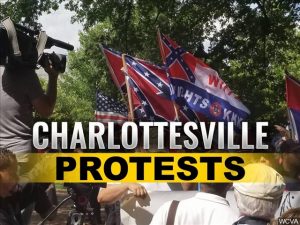 CHARLOTTESVILLE, Va. (AP) — An independent report that found serious police and government failures in responding to violence at a white nationalist rally in Charlottesville this summer also accuses police agencies of putting up roadblocks to the investigation.
CHARLOTTESVILLE, Va. (AP) — An independent report that found serious police and government failures in responding to violence at a white nationalist rally in Charlottesville this summer also accuses police agencies of putting up roadblocks to the investigation.
The report released Friday by former U.S. Attorney Tim Heaphy said Virginia State Police refused to make commanders on the ground at the Aug. 12 rally available for interviews or to provide most documents requested. It also said Charlottesville Police Chief Al Thomas deleted relevant text messages and made officers fearful of retaliation for speaking with investigators.
Thomas’ lawyer denied texts were deleted. He spoke at a news conference in which community activists peppered Heaphy with questions and shouted at Thomas, illustrating the deep distrust between some of Charlottesville’s citizens and law enforcement after white nationalists descended on the Virginia city over its decision to remove a Confederate monument.
“We are a community divided. We are still a community in crisis,” Thomas said.
The report’s findings come a little over three months after the rally, which was believed to be the largest gathering of white nationalists in at least a decade. Street fights erupted between white nationalists and counterdemonstrators before the event officially began, and the brawling lasted nearly an hour in view of officers until authorities forced the crowd to disband.
Later, as counterdemonstrators were peacefully marching downtown, a car drove into the crowd, killing 32-year-old Heather Heyer and injuring many more.
Heaphy’s report was sharply critical of Thomas’ response as the violence began to escalate that day.
According to the report, as brawling first broke out, Thomas said, “Let them fight, it will make it easier to declare an unlawful assembly.”
Thomas did not recall making that statement, which was cited in accounts by two other police employees, though he confirmed he waited to “see how things played out” before declaring an unlawful assembly, the report said.
“Chief Thomas’ slow-footed response to violence put the safety of all at risk and created indelible images of this chaotic event,” it said.
The report also said Thomas initially tried to limit access to certain information by directing subordinates not to answer certain questions. And it said Thomas and other Charlottesville police command staff deleted text messages relevant to the investigation.
Kevin Martingayle, an attorney for Thomas, said the chief disputes that.
Heaphy, now in private law practice, said he eventually got the information needed from city police, but that wasn’t the case with Virginia State Police.
State police allowed Heaphy’s team to interview the agency’s leader and two troopers not present the day of the rally. But the report said state police refused requests to interview four others “important to our evaluation” and turned over just one document.
Heaphy’s team said it obtained a second document, a detailed plan for state police resources on Aug. 12, after copies were accidentally left behind in a staging area.
State police Col. W. Steven Flaherty issued a statement Friday evening that did not directly address the report’s characterization of the agency as unwilling to cooperate.
The statement said the rally brought individuals “from both the extreme right and extreme left” to Charlottesville “with the sole purpose of provoking violence from the opposing side.”
“In that kind of volatile and rapidly-evolving environment, it is difficult for any one police plan to account for every possible circumstance and resulting scenario,” Flaherty said.
Virginia’s Secretary of Public Safety and Homeland Security Brian Moran was initially willing to cooperate with Heaphy’s investigation, the report says, but Moran’s office later invoked executive privilege over certain information amid concerns about possible litigation against the state.
Moran didn’t respond to AP’s requests for comment.
The investigation — which involved around 150 interviews and a review of photos, video and more than half a million documents — found a lack of coordination between state and city police and a passive response to the chaos.
The report also found police removed an officer from the area where the car smashed into counterdemonstrators, leaving only a small sawhorse in place at the time.
The report also said the fact that officers were dressed in everyday uniforms, not riot gear, at the outset caused problems. Their helmets and shields were staged behind barricades, not beside officers, Heaphy said, requiring them to leave conflict areas to retrieve that equipment.
“Supervisors devised a poorly conceived plan that under-equipped and misaligned hundreds of officers. Execution of that plan elevated officer safety over public safety,” the report said.



